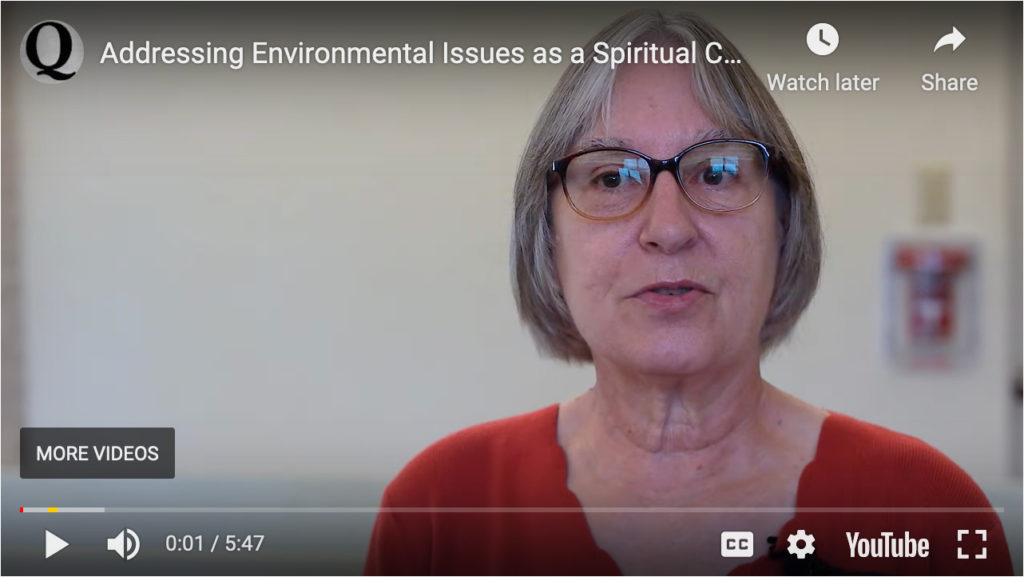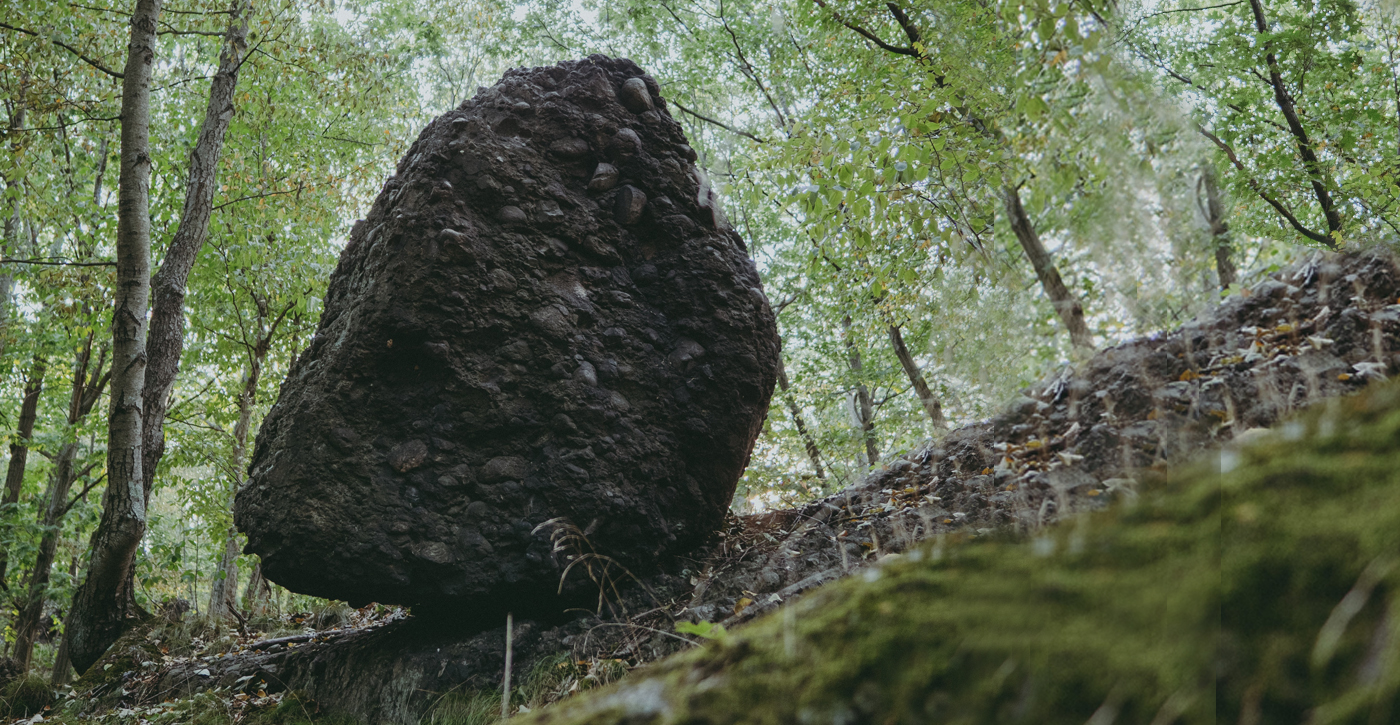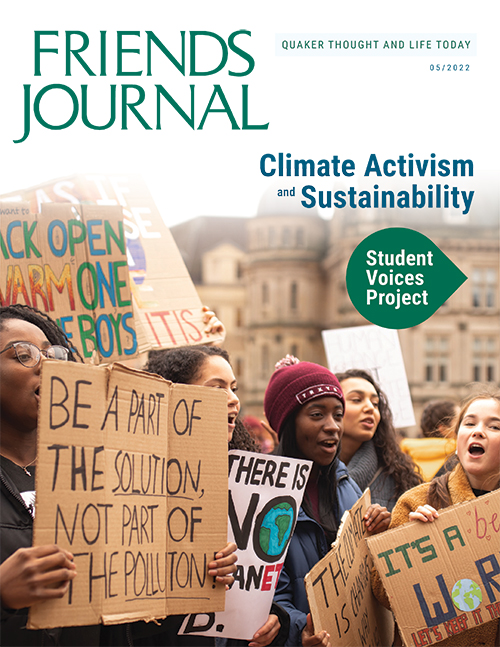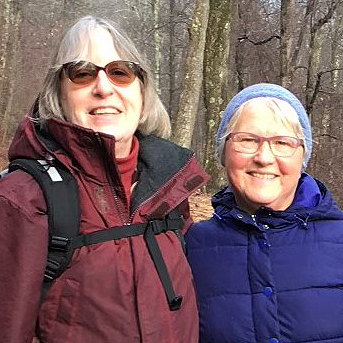Two years ago, the peace and social action committee of State College (Pa.) Meeting surveyed members and attenders and asked where they wanted the committee to focus their energies. The concern that was listed most was climate change, and our Climate Justice Working Group (CJWG) grew out of this expressed concern. In this article, two members of this committee share their personal stories of climate activism. One focuses on personal lifestyle choices to sustain the planet; the other focuses on what one person does to sustain herself in the work.
Jackie’s Story
My childhood love of the natural world led to an environmental studies degree and a lifelong effort to live more lightly on our pretty, blue planet. Now, as part of our meeting’s Climate Justice Working Group, we work on educating ourselves, meeting members, and the wider community on acting like well-grounded, responsible citizens of nature’s community rather than a dominant, completely separate species, which mistakenly considers itself to be above consequences. The urgency inside us is growing: we have only a short time before we reach tipping points that cannot be undone, and the need for wise action across the globe has become existential for thousands of species. This bodes ill for Homo sapiens’ survival as well.
As of 2021, four in ten people in the United States live in counties adversely affected by the climate crisis; our entitled culture is starting to deal with the fact that climate change is—yes, indeed—real, costly, can’t be wished away, and is going to affect us detrimentally for years. Middle-class White people are becoming climate migrants in the United States. A majority of Black and Brown people, who have already been adversely affected by toxic, degraded environments and intentionally financially hamstrung for generations, are even more impacted.
Re-learning restorative and regenerative practices and lifeways is vital: it truly means life. Indigenous cultures were well-adapted to the habitats and ecosystems in which they lived. Non-Indigenous people have much to learn about living in better balance with and respect for the many lives and communities that sustain our own. One rich source of this knowledge comes from the descendants of those who survived colonization. Indigenous wisdom is place-based, observant of the web of life, and takes care not to smash the multitude of interconnections and relationships that keep Earth healthy and a living whole.
What can be done to realign our lives to become more sustainably responsible earth citizens? If you own a home, get a home energy audit to learn about and implement the many home improvements that minimize energy waste, such as insulating the attic and house walls, replacing and upgrading windows and doors, installing a mini-split heat pump, installing programmable thermostats, buying wind-generated electricity, or installing a solar array. Outdoors, one can transform monoculture lawns into diverse gardens for local eating. Permaculture and organic gardens that are complete with compost piles replace soil nutrients. One can mow any remaining lawn and pathways with an electric mower and weed whacker. Changing one’s diet to consume less beef and pork and buy more from local farmers who pasture raise their animals cuts down on methane, transportation gas use, and animal misery found in CAFOs (concentrated animal feed operations). Switching to an electric vehicle, limiting flying miles, using public transport, and biking and walking more are ways to cut our CO2 output from transportation. We can also march, protest, write letters, educate, and talk about climate change. Reducing our use of plastic cuts pollution and CO2. There is always more that can be done: we have at least three to five generations of fossil fuel use to undo while adapting to a wildly erratic climate that is squeezing the plant and animal life upon which we depend for food. Can we unite to establish a new pattern of human lifeways in time? I believe it is a question each of us must answer in order to live our Quaker values.
Our Climate Justice Working Group offered an educational webinar on seven personal and home-related ways to take stewardship action for climate change mitigation. I offer a summary of our work, in hope that it may be useful to others in finding the sustainable path that most calls to them.
- Gender equality worldwide can be supported by educating girls and securing women’s voluntary right to high-quality family planning. According to Drawdown edited by Paul Hawken, these two activities combined could reduce atmospheric carbon dioxide by 85 gigatonnes, making this one of the most powerful solutions to climate change. The Global Footprint Network determined that if everyone lived like Americans, we would need five Earths to supply the resources demanded.
- Traveling without fossil fuel mitigates climate change. In order of priority, people can walk and bike; use electric cars and carpool; use public transportation; and, if you must fly, use a carbon offset for the CO2 produced. According to Our World in Data, aviation “accounts for around 2.5 percent of global CO₂ emissions, but 3.5 percent when we take non-CO₂ impacts on climate into account.”
- CO2 emissions can be lowered by cutting back on red meat, especially if not pasture-raised, and eating local involves fewer shipping miles.
- If you own property, you can get a home energy audit to identify the best areas to save with energy efficiency upgrades. Complete the improvements as you are able. There are lower cost improvements you can do to help if more expensive items are out of reach at first.
- Switch to an all-electric home and, if possible, install a solar array or purchase wind-generated electricity.
- Look at your savings and insurance investments, if you have them, and ensure they are not supporting fossil fuels; if they are, invest instead in renewable technologies. Make sure companies know why you are switching your investments.
- Be vocal about climate! Young people’s futures are at stake: protest loudly and support them. Many elders have more monetary power, so they can support young activists by refusing to vote for or finance fossil fuel candidates or companies. Write letters, talk to legislators, inform family and neighbors; don’t stay silent. Some rising organizations are Third Act (started by Bill McKibben and aimed at engaging activists over age 60), Earth Quaker Action Team (EQAT), and the Sunrise Movement.
We have five to nine years to blunt the worst effects of climate change. We can’t reverse the effects already happening from former CO2 released by years of fossil fuel burning. Let’s not stampede off the cliff; we need to acknowledge it is there and turn away in time.

Addressing Environmental Issues as a Spiritual Community, March 2022 interview with Jackie Bonomo, available at QuakerSpeak.org.
Dorothy’s Story
Two years ago was the first time I labeled myself a climate change activist. It wasn’t surprising or out of character for me. I spent my childhood playing in the woods and mucking in creeks, and as an adult, I’ve spent as much time as possible camping, backpacking, hiking, and gardening. When I look back on my life, I don’t regret even one minute of the time I spent outdoors. In the 1970s, I began living a lifestyle grounded in earthcare and simplicity: organic gardening, recycling, composting, natural foods, reusing, and shopping at thrift stores. For 30 years as an early childhood educator, I taught young children environmental awareness and earthcare through school gardens, recycling projects, earth sciences, and outdoor exploration. I was certain that by living lightly on the earth, I was a part of saving the earth from future destruction. But I felt my perspective shift when a Friend at our meeting said, “For most of my life, I’ve bicycled almost everywhere . . . and still climate change happened!”
I know I’m not alone in feeling despair, disappointment, and anger over climate change. If I had my life to do over, I would still live with the same values and actions, but now I have a broader sense and understanding of the limitations and power that personal lifestyle choices can have on climate change.
Two years ago, I took my first step toward climate activism by joining State College (Pa.) Meeting’s Climate Justice Working Group. The learning curve for me has been steep, and often challenging and confusing. I don’t have a background in science, so it has been empowering for me to learn the science of climate change. I’ve also learned about advocacy and policy, and the connection between race and social justice and climate change. I sometimes find the amount of information available to be overwhelming. In addition to having access to reliable information, I’ve been fortunate to have informed and critical thinking guides to help me as I rethink beliefs and values that I now believe aren’t in line with the existential threat we are facing. In The New Climate War, Michael E. Mann critiques the widespread emphasis that is put on changing personal lifestyle behavior, rather than holding powerful institutions like corporations, government agencies, banks, and universities accountable for their contributions to climate change. Eileen Flanagan, a Quaker environmental activist involved with EQAT, helped me understand that personal environmental practices, like carrying a reusable water bottle, can be important spiritual practices for living with integrity but they aren’t a powerful tool for creating systemic and institutional change.
Many people in the United States are distraught over the impact of climate change, and many people are struggling, wanting to know where to put their energy but not sure what to do. Like them, I want to put my weight, energies, and skills where they will have the largest impact. Trying to discern how to do that often leaves me bewildered, and that brings up feelings of hopelessness and helplessness. What I know how to do—like planting a pollinator garden and sharing information about alternative energy—seems puny and “too little, too late.” I feel frozen at the idea of organizing our community to persuade a local institution to divest from fossil fuels: a possible target we’ve considered is Penn State University, one of the largest universities in the country with nearly 90,000 students and a $7 billion budget.
I have found ways to sustain myself and stay inspired when I’m feeling hopeless and helpless. I revisit memories of being in my garden, hiking in the mountains, camping under ancient trees, and I tap into the deep feelings I have of desperately wanting these experiences to remain possible for future generations. I get a sick feeling in my stomach when I think about the world 10, 20, 30 years from now and imagine what the living conditions might be then; how much of nature might be missing: trees, plants, animals, clean water, and clean air. Already, due to environmental injustice, some groups of people are disproportionately suffering because of the destruction of our ecosystems and the absence of clean water, healthy air, soil that can produce food, too much or too little water, raging fires, famine, social disruption, and wars. Thinking about future generations inspires me to keep working despite my uncertainties.
I also get sustenance from my spiritual connection to the natural world. I’m fed in so many ways by being in nature. Physically I feel healthy, and spiritually I feel whole. Recently I was on a hike with my family in central Pennsylvania. It was late afternoon, and we were following a trail through a narrow, forested hollow. We all noticed the beautiful, bright sun as it slowly set behind the steep slope on the other side of the hollow. The steep slope was covered with deep greens of hemlocks and rhododendrons, and as the sun disappeared behind it, the hillside gradually settled into a cool, shadowed darkness that contrasted with the sunny warmth where we were standing. My seven-year-old granddaughter stood still and watched this magical transformation. She said quietly, “That’s so beautiful.” I felt my spirit fill. And I felt a sense of sorrow at the same time. I felt heartsick knowing that my grandchildren’s generation might lose that opportunity for awe and wonder at the natural world, and a connection with something that is truly sacred. The opportunity to stand still in the miracle of our earth, and experience grace—unearned. I remind myself that so far, the gift of nature has been unearned, but now I believe I have to earn it.
Recently, I listened to an On Being podcast interview with Katharine Hayhoe, an atmospheric scientist, entitled “The Future Is Still in Our Hands.” There’s an image that she described that I’ve been returning to when I feel overwhelmed and disappointed, and want to give up. She said:
We think of climate action as a giant boulder sitting at the bottom of an incredibly steep hill, and it’s only got a few hands on it. And so there’s just no way we’re going to make it up that hill. Like, just forget it. Why even waste my time? That’s sort of mentally how we think. But the reality is, when we start to look around and see that 90 percent of new energy installed last year, during COVID, was clean energy, and we start to see that cities all over the world are taking action on climate change, and big businesses, like Microsoft and Apple and AT&T—you know, they’re building the biggest solar farm in the United States, outside of Dallas, to supply major corporations with clean energy. So really, that giant boulder, it is already at the top of the hill, and it’s already rolling down the hill in the right direction, and it already has millions of hands on it. It just doesn’t have enough to get it going faster. And when we think, well, maybe I could add my hand to that, because I could get it going just a little bit faster, that’s totally different than if we think it’s at the bottom of the hill, not budging even an inch. So, I find tremendous hope from that.
I have found hope in that image, too. I’ve got my hands on that boulder.
As a Quaker, I understand that the key to my continued work as a climate change activist is to keep my activism grounded in my spiritual life. Even though I’m not certain what actions to take right now, I can patiently persist in doing what I’m doing, knowing that if I am faithful to opening to Spirit, I will be led to do the work that I’m called to do . . . and for me, it will be enough.
Activism and spirituality are dynamically connected. Our spiritual lives lead us to action in the world, and as we act in the world, we are led back to our spiritual lives for nurture, guidance, and grounding, so we can continue our work in the world. Both are necessary in full measure as we move toward an earth restored.
This story originally published May 1, 2022.





Nice article, but PLEASE do not promote “large solar farms” as a desirable “green” energy development! Large parking lot solar projects are fully green, have added benefits of offsetting heat-island effects without water use by creating a shade layer between sun and pavement, reducing heat-stress in homeless people and urban wildlife, reviving dying community spaces, reducing car A/C needs, and promoting community partnerships. They are currently blocked by the very destructive large solar farms which increase heating (via albedo effects and massive dust pollution trapping heat). Large farms require miles of new transmission lines through “Wild” land, greatly increasing wildfires and opening path for water+power-wasteful industrial and mining complexes. They kill birds and disrupt habitat. Please distinguish between green solar and farms! I live in Las Vegas where conservationists, tribes, and local communities are currently battling against further farm developments in response to dramatically increased local heat, dust, and environmental destruction caused by these farms. We can no longer see stars that were visible 2 years ago, due to dust-haze reflecting urban lights. Not clean energy unless on roof or parking lots!
Thanks, Sascha, for the details on Katherine Hayhoe’s praise of large solar farms. I like the image she paints of the boulder but tend to distrust large corporations’ use of green PR. It can be like freshly painting rotten wood. I learn more every day and it will take many of us adding our detailed perspectives to understand better ways of living on the planet. – Jackie